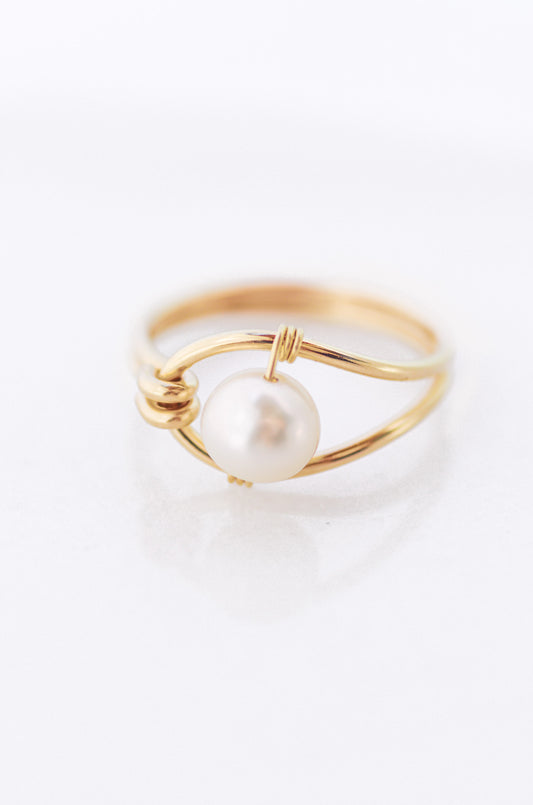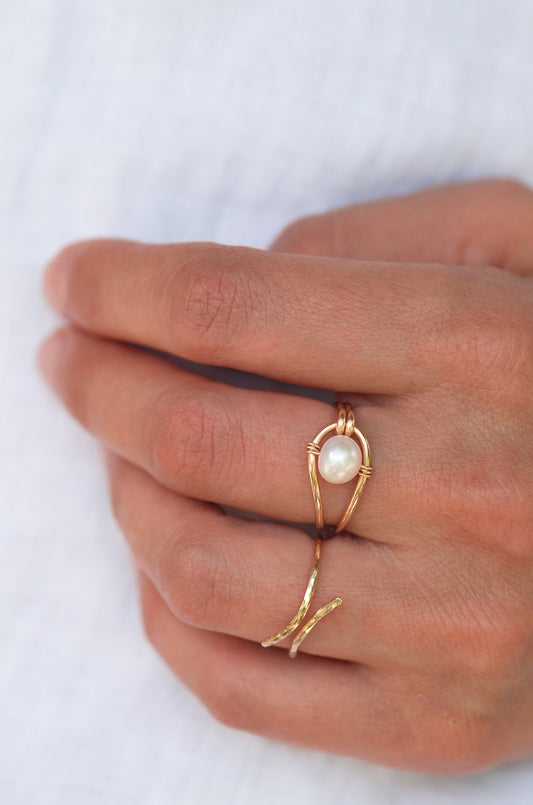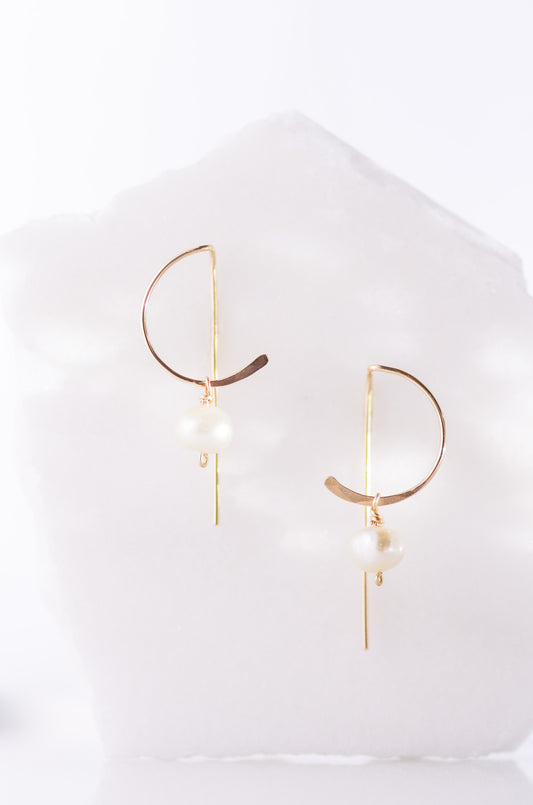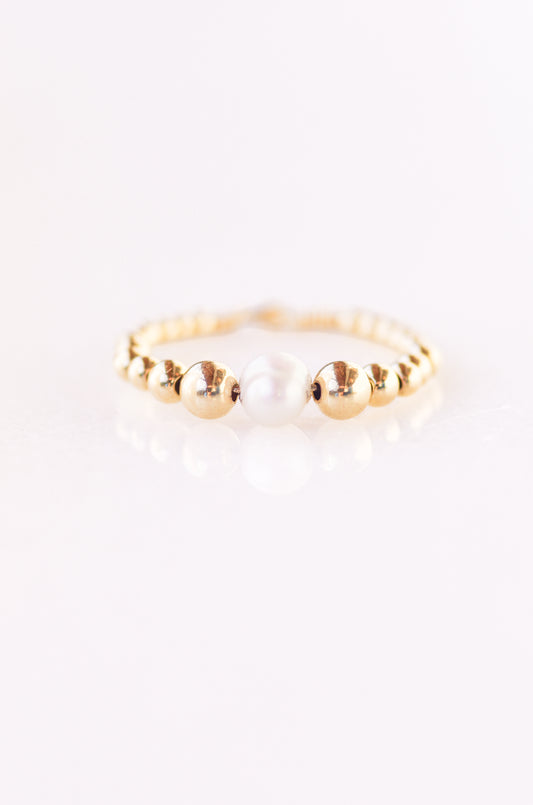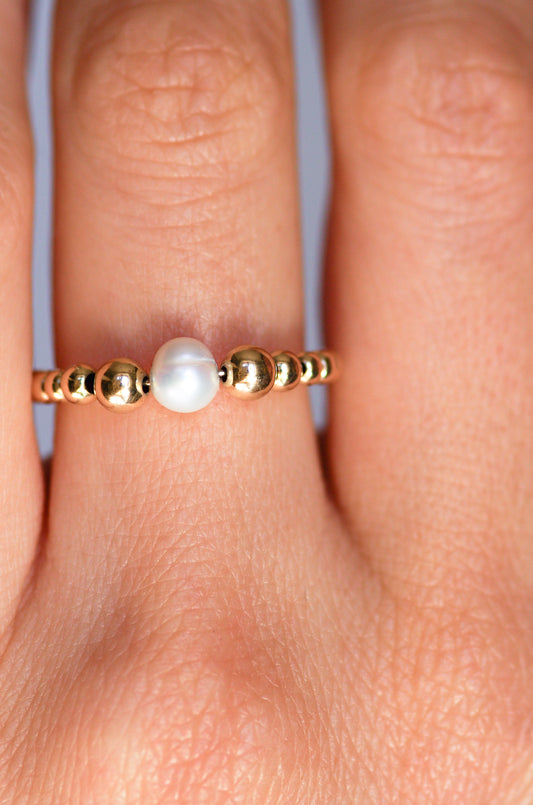The Role of Jewelry in Slow Living and Growth
Teilen
In today’s consumption-driven, fast-paced world, slow living encourages us to make intentional choices and redefine our relationship with material possessions.
The materials we choose, the craftsmanship we support, and the designs we wear all speak to our values and the kind of world we want to help shape.
Investing in quality, ethically made pieces that align with our style and values builds confidence and strengthens our ability to trust our own aesthetic instincts.
- Sustainability: Recycled metals and vintage gems reduce waste and preserve resources.
- Materials Matter: Gold-fill jewelry (jewelry made with 100x more gold) lasts longer than gold-plated, avoids tarnishing and is safe for sensitive skin.
- Ethical Practices: Supporting small-scale artisans ensures fair labor and reduces environmental strain.
- Personal Growth: Jewelry reflects your evolving identity, celebrating memories and milestones.
Intentional Jewelry for Personal Growth and Style
The jewelry we choose speaks volumes about who we are and who we’re becoming. It’s a reflection of our evolving identity. Each piece tells a story, aligning seamlessly with the principles of slow living, where every decision is intentional and rooted in our values.
Design Inspired by Balance and Harmony
When jewelry draws its beauty from timeless natural principles; balance ensures visual stability by distributing elements thoughtfully, harmony emerges when colors and themes work together effortlessly, and unity ties everything together through repeated patterns, textures, and proportions [1][2][3].
At Rays & Riches, these ideas come to life in designs inspired by nature’s patterns, such as the golden ratio - a mathematical principle that creates naturally pleasing proportions. This approach results in pieces that feel organic, balanced, and elegant, embodying the wearer’s thoughtful approach to life. Even the simplest designs carry a sense of purpose and structure [1][2].
This attention to harmony creates a foundation for understanding how jewelry can grow alongside us.
How Jewelry Reflects Personal Change
As our tastes evolve, so does our connection to jewelry. With time, our preferences shift, reflecting personal growth and a deeper embrace of slow living. Pieces that once occupied our drawers may no longer align with our current values or aesthetic.
As we grow, jewelry becomes a mirror of our personal journey. Instead of collecting trendy, fleeting items, we gravitate toward a curated selection that tells our story. Each piece marks a milestone - a chapter of growth, of who we are already becoming, or a newfound appreciation for craftsmanship and sustainability.
Choosing jewelry made from recycled metals or repurposed vintage pearls symbolizes transformation and renewal. These pieces aren’t impulsive buys; they’re deliberate choices that reflect a commitment to mindful consumption and a deeper connection to what matters most.
Building Identity and Confidence
As our values evolve, so does the way we express ourselves. Each piece of jewelry becomes a declaration of who we are becoming. Knowing that our earrings were crafted with chemical-free processes or that our bracelet features ethically sourced materials changes the way we carry ourselves.
Personal expression thrives when we move away from fleeting trends and embrace our own aesthetic. Whether it’s the understated elegance of minimalist designs or the bold playfulness of statement pieces, every selection becomes an affirmation of our individuality.
Investing in timeless pieces that last for years, not months, also reflects a belief in our own permanence and value. In the context of slow living, this idea transcends appearances, emphasizing the satisfaction of knowing our choices reflect our true selves.
The confidence that comes from this alignment creates a ripple effect. Feeling authentic in our self-expression encourages us to make more intentional choices in other areas of life. Jewelry, then, becomes more than an adornment; it becomes a tool for personal growth and a celebration of self-acceptance.
Building a Jewelry Collection That Lasts
Creating a jewelry collection that stands the test of time is all about thoughtful choices. By focusing on pieces that truly resonate with your personal style and values, you can build a collection that feels meaningful and grows with you. This approach not only reduces waste but also deepens your connection to your accessories.
Choosing Timeless and Versatile Pieces
The secret to a lasting collection lies in versatility. Timeless pieces can effortlessly shift from casual mornings to elegant evenings. For instance, a pair of gold-fill earrings can elevate both a simple coffee-run outfit and a chic dinner ensemble. Similarly, a delicate bracelet can complement everything from professional attire to relaxed weekend looks.
When adding new pieces, ask yourself: Does it pair well with at least three outfits you already own?
Quality matters, too. Choose durable materials and opt for shapes and proportions that speak to you. Designs inspired by natural patterns, like the golden ratio, often carry a sense of timeless beauty. These kinds of pieces adapt effortlessly as your style evolves, all while retaining their elegance.
Supporting Ethical Artisans and Practices
Every purchase shapes the future of the jewelry industry. By choosing small-scale, ethical artisans, you're prioritizing craftsmanship over mass production. These creators focus on making pieces designed to last, rather than items meant to be quickly replaced.
Look for artisans who are transparent about their processes. Ethical makers often emphasize sustainability and craftsmanship, building closer relationships with their customers. Whether it’s thoughtful packaging or direct communication, these personal touches set them apart from mass-produced brands.
Supporting ethical practices also means valuing fair labor conditions, clear pricing, and honest sourcing of materials. When you buy from such artisans, you’re supporting responsible business practices. These pieces carry stories and values, making your collection more meaningful and enduring.
Care and Maintenance for Longevity
Even the best jewelry requires care to keep its beauty and value intact. Regular upkeep is key to turning a good piece into a lifelong treasure.
Start with daily habits. Remove jewelry before swimming, working out, or applying lotions and perfumes. Always put your jewelry on last when getting dressed and take it off first at the end of the day. Store each piece separately in soft pouches or lined boxes to prevent scratches and tarnishing.
For cleaning, stick to gentle methods. Use a soft, lint-free cloth to wipe down pieces after wearing. For a deeper clean, warm soapy water and a soft brush work well for most gold-fill items. Avoid harsh chemicals or ultrasonic cleaners, as they can harm delicate components.
When repairs are needed, consult skilled jewelers familiar with the materials of your pieces. Scheduling professional maintenance every few years can address small issues before they turn into bigger problems, significantly extending the life of your jewelry.
Well-cared-for jewelry not only looks stunning but also holds its value over time, transforming it into a true investment rather than just another accessory.
sbb-itb-2024ddf
Materials and Craftsmanship That Matter
The materials used in jewelry tell a story about our values and the way we approach life. Choosing pieces made with care and purpose sends a message about what’s important to us and how our decisions can have a meaningful impact. This perspective invites us to explore the journey behind each material.
Why Materials Matter
Every material carries its own environmental story. Opting for repurposed vintage pearls and gemstones, for example, helps avoid the environmental strain caused by mining and harvesting new resources. At the same time, it preserves the charm and elegance of materials already in existence. Similarly, recycled metals retain their brilliance and quality while reducing the need for new extraction. These thoughtful choices align perfectly with the principles of slow living, emphasizing a more mindful and sustainable way of life.
Gold-Fill vs. Gold-Plated Jewelry
Understanding the difference between gold-fill (jewelry made with 100x more gold) and gold-plated jewelry is key to making informed, intentional choices. Gold-plated jewelry is made by applying a thin layer of gold through chemical processes. While affordable, this layer wears away quickly, often leading to tarnishing and even skin sensitivities. On the other hand, gold-fill jewelry contains a much thicker layer of gold - 100 times more than gold-plated pieces. This layer is bonded to the base metal using heat and pressure, not chemicals, resulting in a more durable and skin-friendly finish. Gold-fill jewelry’s lasting quality aligns with the slow living philosophy of prioritizing durability and thoughtful consumption.
Ethical and Local Production Practices
The way jewelry is crafted is just as important as the materials used. Small-scale, local production not only minimizes transportation emissions but also fosters a deeper connection between the maker and the wearer. Ethical sourcing begins with transparency, ensuring that metals and gemstones are obtained responsibly. Carbon-neutral shipping further supports sustainability throughout the process, from creation to delivery. Choosing jewelry made with these ethical and locally focused practices supports a model that values both people and the planet.
Conventional vs. Ethical Jewelry Practices
In the realm of slow living, the way jewelry is produced plays a crucial role. While conventional jewelry focuses on speed and low costs, ethical practices prioritize environmental care and fair treatment of workers. This shift aligns beautifully with slow living's core values, where thoughtful decisions take center stage.
Conventional jewelry is typically mass-produced in factories that prioritize quantity over quality. These processes often involve harsh chemicals like those used for gold-plated jewelry. This method not only generates toxic waste but also results in pieces that tarnish or wear out within months. The focus is on creating products meant for quick turnover rather than lasting treasures.
On the other hand, ethical jewelry embraces small-scale production, sustainable materials, and transparent practices. The materials used also set ethical practices apart. Conventional jewelry relies on newly mined metals and gemstones, which can lead to significant environmental damage and, in some cases, exploitative labor conditions. Ethical alternatives, however, favor recycled metals and repurposed vintage gemstones, reducing the need for new mining while adding a unique touch to each piece.
Here's a quick comparison of the two approaches:
A Comparison Table of Practices
| Aspect | Conventional Practices | Ethical Practices |
|---|---|---|
| Production Scale | Mass production in large factories | Small-scale, handmade crafting |
| Materials | Newly mined metals and stones | Recycled metals and repurposed vintage gems |
| Gold Application | Gold-plating (thin layer), Chemicals | Heat and pressure bonding, or solid gold |
| Environmental Impact | Chemical use leading to waste and higher emissions | Chemical-free processes and carbon-neutral shipping |
| Durability | Short-lived | Long-lasting |
| Transparency | Limited information about clear sourcing | Full transparency about materials and processes |
| Worker Conditions | Often unclear or problematic | Fair labor practices with local artisans |
| Packaging | Standard, often wasteful | Sustainable and thoughtfully designed packaging |
| Customer Relationship | Transactional, mass market | Personal connection and individual attention |
| Design Philosophy | Trend-driven, fast fashion | Timeless, meaningful designs inspired by balance and harmony |
While ethical jewelry may come with a higher upfront price, its durability makes it a smart long-term investment. For instance, a gold-fill piece (jewelry made with 100x more gold) that lasts for decades delivers far more value than repeatedly replacing short-lived gold-plated items.
Beyond durability, ethical practices also minimize environmental harm and ensure fair labor conditions. Many ethical jewelers, like Rays & Riches, go the extra mile with carbon-neutral shipping, eco-friendly packaging, and direct, personal interactions with their customers. This human connection transforms each piece into more than just an accessory - it becomes a meaningful story.
As consumers grow more conscious of their choices, many are leaning toward businesses that align with their values. In the spirit of slow living, every purchase becomes a deliberate act, reflecting care and intention.
Choosing ethically made jewelry is about embracing a philosophy that values craftsmanship, sustainability, and respect for human dignity. These practices protect our planet and celebrate the beauty of intentional living and meaningful design. Each piece becomes a symbol of something much greater - a commitment to a better way of living.
Conclusion: Jewelry as a Catalyst for Positive Change
Our choices in materials, craftsmanship, and design go beyond aesthetics - they reflect our values and influence the world around us. Jewelry, when chosen thoughtfully, becomes a deliberate expression of our commitment to meaningful change and mindful living.
By shifting from impulsive buying to intentional selection, we redefine our relationship with material possessions. Instead of fleeting trends, we focus on building personal collections that grow with us, reflect our identity, and respect the planet’s finite resources. This mindset transforms jewelry into something enduring - pieces that carry significance and purpose.
Opting for ethically crafted jewelry over mass-produced alternatives sends a clear message. It’s a choice that supports fair labor practices, prioritizes artisanship over speed, and reduces the environmental toll of mining and chemical processes. Each decision not only reduces harm but also uplifts the skilled hands behind the craft.
This thoughtful approach bridges the external and internal. On one hand, it contributes to a healthier planet and fairer practices. On the other, it fosters personal growth. Investing in quality, ethically made pieces that align with our style builds confidence and strengthens our ability to trust our own aesthetic instincts.
It also deepens our connection to beauty and craftsmanship. We start to notice the intricate details of handmade pieces, appreciate the importance of sustainable materials, and value the human stories behind each creation. This connection enriches our experience, making each piece feel more meaningful.
The principles of slow living - mindfulness, quality, and connection - resonate deeply in this journey. Jewelry becomes a reflection of these values, symbolizing our dedication to thoughtful choices and a more intentional way of life. Each piece becomes a small but powerful step toward positive change, both within ourselves and in the world around us.
When seen through this lens, jewelry becomes a catalyst for transformation, inspiring us to live thoughtfully, consume responsibly, and express ourselves authentically. Each piece tells a story - not just of its origin, but of our journey toward a more conscious and impactful life.
FAQs
How does choosing ethically made jewelry support a sustainable and intentional lifestyle?
Choosing jewelry made with ethical practices isn't just a style statement - it's a step toward living more intentionally and sustainably. When you opt for pieces crafted from recycled or responsibly sourced materials, you're actively helping to lessen the demand for new mining, protect natural resources, and reduce environmental harm.
But it doesn't stop there. Ethically produced jewelry often ensures fair wages and safe working environments, supporting the well-being of workers and promoting social responsibility. These thoughtful decisions resonate with the principles of slow living, fostering a sense of personal growth and a stronger bond with the world and the people who share it.
What makes gold-fill jewelry different from gold-plated jewelry, and why is it important?
Gold-fill jewelry stands out for its substantial gold layer, which accounts for at least 5% of the piece's total weight. This makes it more durable than gold-plated jewelry, where the gold layer is so thin it often wears away quickly.
Another thing that sets gold-fill apart is the way it's made. The gold is bonded to the base metal using heat and pressure, avoiding the use of chemicals. This process makes it a more sustainable choice and also means that it's gentle on sensitive skin. Opting for gold-fill means choosing a long-lasting and skin-friendly option that provides excellent durability and value over time.
How does adopting a slow living lifestyle shape the way we choose and cherish jewelry?
Adopting a slow living lifestyle changes the way we think about jewelry. It shifts the focus to quality, durability, and personal significance, rather than chasing after short-lived trends. This mindset encourages choosing timeless pieces that resonate with your values, especially those made from sustainable and ethically sourced materials.
With this thoughtful perspective, jewelry becomes more than just decoration - it turns into a meaningful expression of your personal journey, individuality, and deliberate choices. By selecting pieces that stand the test of time, you embrace a more mindful and sustainable approach to life.

